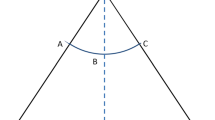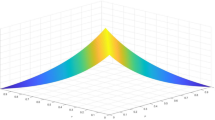Abstract
Distance is an important fundamental concept of the set theory. Since the intuitionistic fuzzy sets (IFSs) was put forward, distance between IFSs has been widely concerned by some researchers and many types of measures have been proposed. However, although intuitionistic fuzzy sets have the advantage of being able to consider waver (lack of knowledge), existing distance measures have not yet considered waver and most of them have counter-intuitive cases. To deal with this problem, this paper introduces the concept of intuitive distance for IFSs, which embodies the property requirements of classical distance measure and highlights the characteristics of intuitionistic fuzzy information. Then, a new intuitive distance measure for IFSs is proposed along with its proofs. After that, a comparative analysis between the intuitive distance measure and the existing distance measures is conducted based on an extended artificial benchmark test set, in which eleven pairs of single-element IFSs are used as an illustration of six typical counter-intuitive cases. Finally, the proposed distance measure is applied to deal with pattern recognition. Results show that the proposed distance does not provide any counter-intuitive cases and the waver that brought from hesitance index can be well reflected.
Similar content being viewed by others
References
Atanassov K (1986) Intuitionistic fuzzy sets. Fuzzy Sets Syst 20:87–96
Atanassov K, Gargov G (1990) Intuitionistic fuzzy logic. C R de L’Acad Bulg Sci 43:9–12
Atanassov K, Gargov G (1989) Interval-valued intuitionistic fuzzy sets. Fuzzy Sets Syst 31:343–349
Atanassov K, Pasi G, Yager RR (2005) Intuitionistic fuzzy interpretations of multi-criteria multi-person and multi-measurement tool decision making. Int J Syst Sci 36:859–868
Bustince H, Burillo P (1996) Vague sets are intuitionistic fuzzy sets. Fuzzy Sets Syst 79:403–405
Boran FE, Akay D (2014) A biparametric similarity measure on intuitionistic fuzzy sets with applications to pattern recognition. Inf Sci 255:45–57
Beliakov G, Pagola M, Wilkin T (2014) Vector valued similarity measures for Atanassov’s intuitionistic fuzzy sets. Inf Sci 280:352–367
Chen SM, Tan JM (1994) Handling multicriteria fuzzy decision-making problems based on vague set theory. Fuzzy Sets Syst 67:163–172
Chen SM, Chang CH (2015) A novel similarity measure between Atanassov’s intuitionistic fuzzy sets based on transformation techniques with applications to pattern recognition. Inf Sci 291:96–114
Chen T-Y (2007) A note on distances between intuitionistic fuzzy sets and/or interval-valued fuzzy sets based on the Hausdorff metric. Fuzzy Sets Syst 158:2523–2525
Chaira T (2011) A novel intuitionistic fuzzy C means clustering algorithm and its application to medical images. Appl Soft Comput 11:1711–1717
De SK, Biswas R, Roy AR (2001) An application of intuitionistic fuzzy sets in medical diagnosis. Fuzzy Sets Syst 117:209–213
Das S, Guha D, Dutta B (2016) Medical diagnosis with the aid of using fuzzy logic and intuitionistic fuzzy logic. Appl Intell 45:850–867
Grzegorzewski P (2004) Distances between intuitionistic fuzzy sets and/or intervalvalued fuzzy sets based on the Hausdorff metric. Fuzzy Sets Syst 148:319–328
Gau WL, Buehrer DJ (1993) Vague sets. IEEE Trans Syst Man Cybern 23:610–614
Intarapaiboon P (2016) A hierarchy-based similarity measure for intuitionistic fuzzy sets. Soft Comput 20:1909–1919
Hong DH, Choi CH (2000) Multi criteria fuzzy decision-making problems based on vague set theory. Fuzzy Sets Syst 114:103–113
Li YH, Olson DL, Qin Z (2007) Similarity measures between intuitionistic fuzzy (vague) sets: A comparative analysis. Pattern Recogn Lett 28:278–285
Papakostas GA, Hatzimichailidis AG, Kaburlasos VG (2013) Distance and similarity measures between intuitionistic fuzzy sets: A comparative analysis from a pattern recognition point of view. Pattern Recogn Lett 34:1609–1622
Szmidt E, Kacprzyk J (1996) Intuitionistic fuzzy sets in group decision making. Notes IFS 2:11–14
Szmidt E, Kacprzyk J (2000) Distances between intuitionistic fuzzy sets. Fuzzy Sets Syst 114:505–518
Szmidt E, Kacprzyk J (2001) Intuitionistic fuzzy sets in intelligent data analysis for medical diagnosis. Lect Notes Comput Sci 20:263–271
Szmidt E, Kacprzyk J (2009) A note on the Hausdorff distance between Atanassov’s intuitionistic fuzzy sets. Notes Intuitionistic Fuzzy Sets 15:1–12
Own CM (2009) Switching between type-2 fuzzy sets and intuitionistic fuzzy sets: an application in medical diagnosis. Appl Intell 31:283–291
Gang Q, Wang H, Feng X (2013) Generalized hesitant fuzzy sets and their application in decision support system. Knowl-Based Syst 37(4):357–365
Vlachos KI, Sergiadis GD (2007) Intuitionistic fuzzy information-applications to pattern recognition. Pattern Recogn Lett 28:197–206
Wang Z, Xu ZS, Liu SS, Tang J (2011) A netting clustering analysis method under intuitionistic fuzzy environment. Appl Soft Comput 11:5558–5564
Song YF, Lei L et al (2016) An evidential view of similarity measure for Atanassov’s intuitionistic fuzzy sets. J Intell Fuzzy Syst 31:1653–1668
Wang W, Xin X (2005) Distance measure between intuitionistic fuzzy sets. Pattern Recogn Lett 26:2063–2069
Chen SM, Tan JM (1994) Handling multi criteria fuzzy decision-making problems based on vague set-theory. Fuzzy Sets Syst 67:163–172
Xu ZS, Yager RR (2006) Some geometric aggregation operators based on intuitionistic fuzzy sets. Int J Gen Syst 35:417–433
Xu ZS (2007) Some similarity of intuitionistic fuzzy sets and their applications to multiple attribute decision making. Fuzzy Optim Decis Mak 6:109–121
Xu ZS, Chen J (2008) An overview of distance and similarity measures of intuitionistic fuzzy sets. Int J Uncertain Fuzziness Knowl-Based Syst 16:529–555
Yang Y, Chiclana F (2012) Consistency of 2D and 3D distances of intuitionistic fuzzy sets. Expert Syst Appl 39:8665–8670
Zadeh LA (1965) Fuzzy sets. Inf Control 8:338–353
Zhou L, Wu W, Zhang W (2009) On characterization of intuitionistic fuzzy rough sets based on intuitionistic fuzzy implicators. Inf Sci 179:883–898
Zhang H, Yu L (2013) New distance measures between intuitionistic fuzzy sets and interval-valued fuzzy sets. Inf Sci 245:181–196
Song YF, Lei L et al (2015) A novel similarity measure on intuitionistic fuzzy sets with its applications. Appl Intell 42:252–261
Acknowledgments
We greatly appreciate the editor’s encouragement and the reviewers’ valuable comments and suggestions to improve this paper. This work was supported by the National Natural Science Foundation of China under Grant 61273275.
Author information
Authors and Affiliations
Corresponding author
Rights and permissions
About this article
Cite this article
Luo, X., Li, W. & Zhao, W. Intuitive distance for intuitionistic fuzzy sets with applications in pattern recognition. Appl Intell 48, 2792–2808 (2018). https://doi.org/10.1007/s10489-017-1091-0
Published:
Issue Date:
DOI: https://doi.org/10.1007/s10489-017-1091-0




